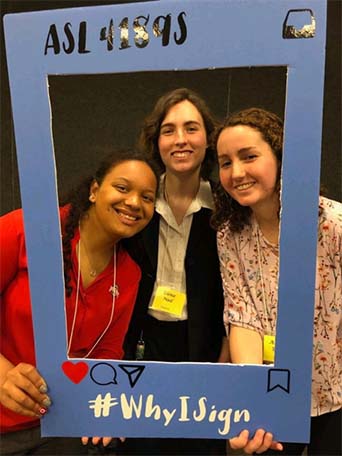
Frequently Asked Questions
“Intersection of American Sign Language, Deaf Culture, and the Deaf Community” is designed to increase student awareness of agencies, businesses, organizations, and schools that serve the deaf and hard of hearing communities. * Students will have the opportunity to use American Sign Language (ASL) with fluent users and apply their understanding of cultural norms and expectations while providing needed services and support. Students will serve at one site throughout the course of the semester, culminating in an ePortfolio and presentation that synthesize their journey toward developing citizenship and allyship through service with the community partner site.
*Deaf and Hard of Hearing Communities includes, but not limited to: DeafBlind, DeafDisabled, hard of hearing, late-deafened, and signers.
Yes. Students must complete ASL 1101 before taking ASL 4189S. Completion of ASL 1103 is preferred. No signature is required.
Yes, 3 semester credit hours. All students are required to have a current, completed FBI/BCI background check by the start of the semester. Contact OSU Human Resources by email at hr-backgroundchecks@osu.edu. More details will be explained by email to students upon registering the course.
The class may enroll up to 24 students.
Service Learning & Civic Engagement, Cultural Competence, Leadership in Service Learning, Reflective learning, and accountability and responsibilities while engaged within the deaf communities.
Students will be placed in different agencies/organizations serving the deaf communities within central Ohio, no more 30 miles within the range from OSU. The type of community partners agencies/organizations may be a social service agency, a group home, nursing and/or rehabilitation facility, independent living housing, school/educational programs for deaf and hard of hearing students, and/or advocacy agency specializing in anti-violence. On-site service includes hands-on tasks involving communicating with those who use ASL whether it be providing direct service to the consumers who are deaf, deafblind, deafdisabled, hard of hearing or late-deafened or support to professionals who may be deaf or hearing serving these deaf communities.
Students are responsible for their own transportation to the off-campus community partner. A few of the community partner sites are on the COTA bus line. Most sites are in Franklin County; one site is located in Delaware County. Students without their own car may also try to arrange a carpool with other students placed at the same community partner. Students should figure travel time into their schedule of availability for service.
Students will commit to a minimum of 35 service hours throughout the semester.
Transportation time to and from the community partner site is not counted toward service hours.
Student’s hours will be determined with the community partner. However, students need to understand flexibility depends on schedule availability and/or shceduled hours may change at the last minute due to demand for client intervention, medical/court appointments, or meetings outside of the community site requiring additional time for travel. Constant communication with community partner is crucial to adjusting schedules and completing your hours for 35-hour minimum of coursework.
Yes. These assignments require submission to Carmen, participation in class discussions, keeping track of community service hours, reflecting on service experiences, presenting at a community event, and attendance to class according to the syllabus, including during final exam week.
The “S” indicates the course has been approved by the university to have a service-learning designation.
No, this course is not currently approved as a GE. However, students may contact their program to request approval.
No, this course is not on the approved list for Disability Studies. However, students may contact their program to request approval.
- Positive attitude.
- Respect for diversity.
- Willingness to make mistakes.
- Willingness to ask for clarification.
- Ability to accept criticism and feedback.
- Flexibility with time, schedule, and situations.
- Self-advocacy/willingness to request guidance or help.
Questions should be directed to the team instructors, Marla Berkowitz berkowitz.44@osu.edu and Kristin Wickham-Saxon wickham-saxon.1@osu.edu.
- “I absolutely loved the experience of using ASL outside of a classroom setting and would encourage others to apply to take this unforgettable course!!”
- “I would definitely recommend it, and I would do it 100x over. I felt needed at (my community partner site), and I feel way more confident in myself and in my people skills. I will continue to help out at (my community partner site) this summer. Also, our classes held on campus were my favorite out of all 4 of my years at OSU. I love learning through activities.”
- “Gosh, it's hard to name the most valuable thing I learned. You will learn a lot in this class. Most generally, I learned so much more about Deaf culture and I learned how to interact with both Deaf and disabled individuals comfortably and appropriately. I learned about many different social issues facing Deaf and disabled people and how I can use my privilege for good.”
- “Signing now just feels more natural. I would encourage people to break out of their comfort zones. When I first started at (my community partner) on day one I tried speaking with a deaf-blind woman, and although I was nervous it was a lot easier than I thought it would be. Actually, (she) now knows it is me when I talk to her because we have interacted so much.”
- “Everyone has a different story, it is important to put yourself in situations where you don't feel comfortable, and the Deaf community is extremely helpful and patient with people with intermediate signing skills!”
Student E-Portfolio
While serving at one site, ASL 4189S students develop awareness of agencies, businesses, organizations, and schools that serve *deaf and hard of hearing communities.
Students use American Sign Language (ASL) with fluent signers and apply their understanding of cultural norms and expectations while providing needed services and support.
These student-designed ePortfolios illustrate students’ synthesis of their overall service-learning journey toward developing citizenship and allyship through service with their community partner site.
*Deaf and Hard of Hearing Communities includes, but not limited to: DeafBlind, Deaf Disabled, Hard of Hearing, Late-Deafened, and Signers.
